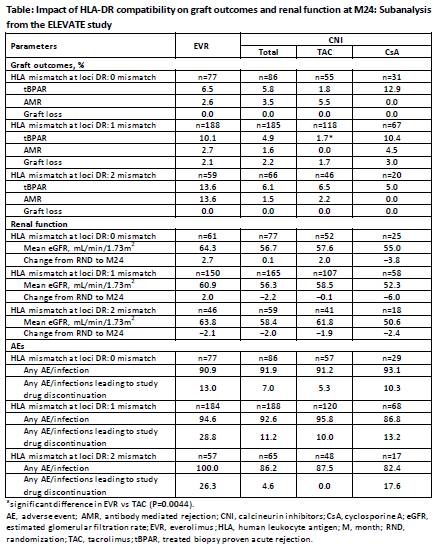Impact of HLA-DR Compatibility on Efficacy Outcomes and Renal Function in Kidney Transplant Recipients Following Early Switch from Calcineurin Inhibitor to Everolimus: Subanalysis from the ELEVATE Study.
ELEVATE study group, Llobregat Catalunya, Spain.
Meeting: 2016 American Transplant Congress
Abstract number: B104
Keywords: Efficacy, HLA-DR antigens, Kidney transplantation, Renal function
Session Information
Session Name: Poster Session B: Drug Minimization
Session Type: Poster Session
Date: Sunday, June 12, 2016
Session Time: 6:00pm-7:00pm
 Presentation Time: 6:00pm-7:00pm
Presentation Time: 6:00pm-7:00pm
Location: Halls C&D
Background: Human leukocyte antigen (HLA) compatibility between donor and recipient is considered an important factor for graft outcomes. Compatibility is associated with a lower incidence of rejection and improved graft survival. The ELEVATE study was designed to evaluate the impact of early conversion from calcineurin inhibitor (CNI) to everolimus (EVR) after kidney transplant (KTx). Here, we present the 24-month (M) data on the impact of HLA mismatch on graft outcomes and renal function.
Methods: ELEVATE (NCT01114529) is a 24M, multicenter, open-label study, in which de novo KTx recipients (KTxRs, N=717) were randomized at 10-14 weeks post-KTx to EVR (n=360; C0:6–10 ng/mL) or to continue standard CNI regimen (n=357; tacrolimus [TAC] C0: 5–10 ng/mL; cyclosporine [CsA] C0: 100–250 ng/mL); all received EC-MPS + steroids. Treated biopsy-proven acute rejection [tBPAR], antibody mediated rejection (AMR) and graft loss at M24 post-Tx were assessed. Rejection episode were included only if diagnosed after conversion. Renal function was assessed as estimated glomerular filtration rate (eGFR, MDRD4).
Results: Patients with no HLA-DR mismatch showed a comparable incidence of tBPAR between EVR and CNI arms. A trend of increasing incidence of tBPAR was noted with higher mismatches in the EVR arm. A comparable incidence of AMR was noted between arms, however it was significantly higher with 2 mismatches in EVR vs CNI (P=0.013). The incidence of graft loss was similar across arms. Overall, eGFR was better in EVR vs CNI arms. The incidence of AEs was comparable between arms, though AE/infections leading to discontinuation were higher in EVR arm [Table].
Conclusion: The findings of current study, though limited by small sample size, suggest that HLA-DR matching may influence graft outcomes. An increase in the incidence of tBPAR was observed in the EVR arm with increasing HLA-DR mismatch. HLA-DR mismatch did not alter eGFR compared to HLA-DR match, however, better renal function was observed within the EVR arm vs CNI arm.

CITATION INFORMATION: Cruzado J, Holdaas H, Lopez P, Aguilar J, Dong G, Claas F, Arns W, van der Giet M, de Fijter J. Impact of HLA-DR Compatibility on Efficacy Outcomes and Renal Function in Kidney Transplant Recipients Following Early Switch from Calcineurin Inhibitor to Everolimus: Subanalysis from the ELEVATE Study. Am J Transplant. 2016;16 (suppl 3).
To cite this abstract in AMA style:
Cruzado J, Holdaas H, Lopez P, Aguilar J, Dong G, Claas F, Arns W, Giet Mvander, Fijter Jde. Impact of HLA-DR Compatibility on Efficacy Outcomes and Renal Function in Kidney Transplant Recipients Following Early Switch from Calcineurin Inhibitor to Everolimus: Subanalysis from the ELEVATE Study. [abstract]. Am J Transplant. 2016; 16 (suppl 3). https://atcmeetingabstracts.com/abstract/impact-of-hla-dr-compatibility-on-efficacy-outcomes-and-renal-function-in-kidney-transplant-recipients-following-early-switch-from-calcineurin-inhibitor-to-everolimus-subanalysis-from-the-elevate-stu/. Accessed December 21, 2025.« Back to 2016 American Transplant Congress
